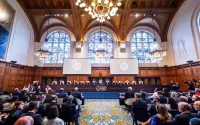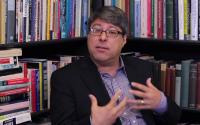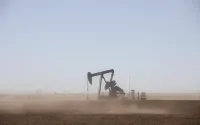20 December 2005Environment News Service
Permafrost is losing its permanence across the Northern Hemisphere, altering ecosystems and damaging roads and buildings across Alaska, Canada, and Russia. Government scientists warned today that over half the area covered by this topmost layer of permafrost could thaw by 2050 and as much as 90 percent by 2100.
New climate simulations from the National Center for Atmospheric Research (NCAR) in Boulder show that global warming may melt the top 10 feet (3 meters) or more of the frozen soil.
s "People have used models to study permafrost before, but not within a fully interactive climate system model," says NCAR's David Lawrence, the lead author. The coauthor is Andrew Slater of the University of Colorado's National Snow and Ice Data Center. The scientists predict the thawing permafrost will increase runoff to the Arctic Ocean and release vast amounts of carbon dixoide into the atmosphere, increasing the greenhouse effect.
Permafrost occurs under about 85 percent of Alaska's surface area, and patches of permafrost can be found as far south as Anchorage. Recent warming has degraded large sections of permafrost across central Alaska, with pockets of soil collapsing as the ice within it melts. The results include buckled highways, destabilized houses, and "drunken forests," trees that lean at wild angles, the authors say.
In Siberia, some industrial facilities have reported significant damage. Further loss of permafrost could threaten migration patterns of animals such as reindeer and caribou.
The study is the first to examine the state of permafrost in a global model that includes interactions among the atmosphere, ocean, land, and sea ice as well as a soil model that depicts freezing and thawing. The scientists used the Community Climate System Model (CCSM) based at NCAR.
The CCSM simulations are based on high and low projections of greenhouse gas emissions for the 21st century, as constructed by the Intergovernmental Panel on Climate Change. In both cases, the CCSM determined which land areas would retain permafrost at each of 10 soil depths extending down to 11.2 feet (3.43 meters).
Results appear online in the December 17 issue of "Geophysical Research Letters." The study was funded by the National Science Foundation, which is NCAR'S primary sponsor, and the U.S. Department of Energy.
About a quarter of the Northern Hemisphere's land contains permafrost, defined as soil that remains below 32 degrees F (0 degrees C) for at least two years.
Permafrost has an active surface layer, extending anywhere from a few centimeters to several meters deep, which thaws during the summer and refreezes during the winter. The deeper permafrost layer remains frozen.
The active layer responds to changes in climate, expanding downward as surface air temperatures rise. Deeper permafrost has not thawed since the last ice age, over 10,000 years ago, and will be largely unaffected by global warming in the coming century, says Lawrence. For the high emission scenario, the area with permafrost in any of these layers shrinks from four million to just over one million square miles by the year 2050 and decreases further to about 400,000 square miles (one million square kilometers) by 2100.
In the low emission scenario, which assumes major advances in conservation and alternative energy, the permafrost area shrinks to about 1.5 million square miles by 2100.
"Thawing permafrost could send considerable amounts of water to the oceans," says Slater, who notes that runoff to the Arctic has increased about seven percent since the 1930s.
In the high-emission simulation, runoff grows by another 28 percent by the year 2100. That increase includes contributions from enhanced rainfall and snowfall as well as the water from ice melting within soil.
The new study highlights concern about emissions of greenhouse gases from thawing soils. Permafrost may hold 30 percent or more of all the carbon stored in soils worldwide. As the permafrost thaws, it could lead to large-scale emissions of methane or carbon dioxide beyond those produced by fossil fuels.
"There's a lot of carbon stored in the soil," says Lawrence. "If the permafrost does thaw, as our model predicts, it could have a major influence on climate."
To address this and other questions, Lawrence and colleagues are now working to develop a more advanced model with interactive carbon.
If this widespread permafrost thaw comes about, "It will change the face of southern Alaska," says Tom Osterkamp. A professor of physics at the University of Alaska Fairbanks Geophysical Institute, Osterkamp has studied Alaska's permafrost for 25 years. Osterkamp monitors the temperature of permafrost with a network of one-inch holes drilled in permafrost throughout the state. The holes, located near Fairbanks, Anchorage, Bethel, Glennallen, Eagle, and other towns and villages, have all been telling the same story. Since 1989, each time Osterkamp has checked the temperatures of permafrost at depths from 10 to 25 meters, the permafrost has crept closer to the melting point.
Osterkamp's recent measurements show that all permafrost south of the Yukon River is warming, and in most cases there isn't one degree left between ice and water.
In addition to creating roller coaster roads and tilting buildings, Osterkamp says, thawing permafrost often causes large sections of forest to collapse, killing trees and other vegetation that live on a foundation of permafrost.






